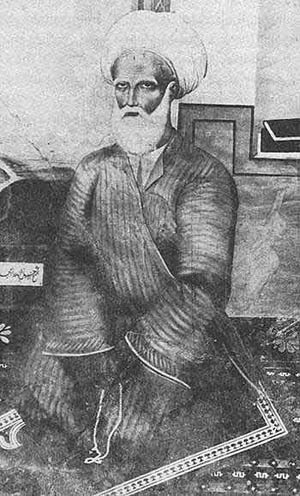| Founder of the S̲h̲ayk̲h̲í School, whose doctrines prepared the way for the Báb. S̲h̲ayk̲h̲ Aḥmad was born around 1743 in Aḥsá, Arabia. He was a respected interpreter of Islamic Doctrine in the S̲h̲í'ih holy cities of Najaf and Karbilá, where he was named a mujtahid. Shayk̲h̲ Aḥmad attracted manu disciples, although his teachings differed from accepted S̲h̲í'ih beliefs. He taught that such concepts as resurrection, Muḥammad's Night Journey to heaven, and signs of the coming Qá'im, should be interpreted metaphorically and spiritually, rather than literally as physical events. S̲h̲ayk̲h̲ Aḥmad was certain that the time of the coming of the long-awaited Qá'im was near. |
| |
| S̲h̲ayk̲h̲ Aḥmad traveled to Persia, where in Yazd Siyyid Kázim-i-Ras̲h̲tí became his disciple and designated successor. On a pilgrimage to Mecca and Medina in 1828, S̲h̲ayk̲h̲ Aḥmad died at about age eighty-one and was buried near the tomb of Muḥammad in Medina. |
| [BD 12] |
 |
| The first of the "twin resplendent lights" who heralded the Báb and Bahá'u'lláh.
Born 1753, died near Medina at the age of 81. (GPB 92; DB 42). |
| [BG 46] |
 |
| S̲h̲ayk̲h̲ Aḥmad ibn Zayn al-Dín ibn Ibráhím al-Aḥsá'í (Arabic: شيخ أحمد بن زين الدين بن إبراهيم الأحسائي) (1753-1826) was the founder of a 19th-century Shi`i school in the Persian and Ottoman empires, whose followers are known as S̲h̲ayk̲h̲ís. |
He was a native of the Al-Ahsa region (Eastern Arabian Peninsula), educated in Bahrain and the theological centers of Najaf and Karbala in Iraq.[1] Spending the last twenty years of his life in Iran, he received the protection and patronage of princes of the Qajar dynasty.[2] |
| [Wikipidia - S̲h̲ayk̲h̲ Aḥmad] |
 |
| See also: |
|
 |
| |
 |
| Shaykh Ahmad ibn Zayn al-Dín ibn Ibráhím al-Aḥsá'í |
[  ] [Wikipedia - Shaykh Ahmad] ] [Wikipedia - Shaykh Ahmad] |

